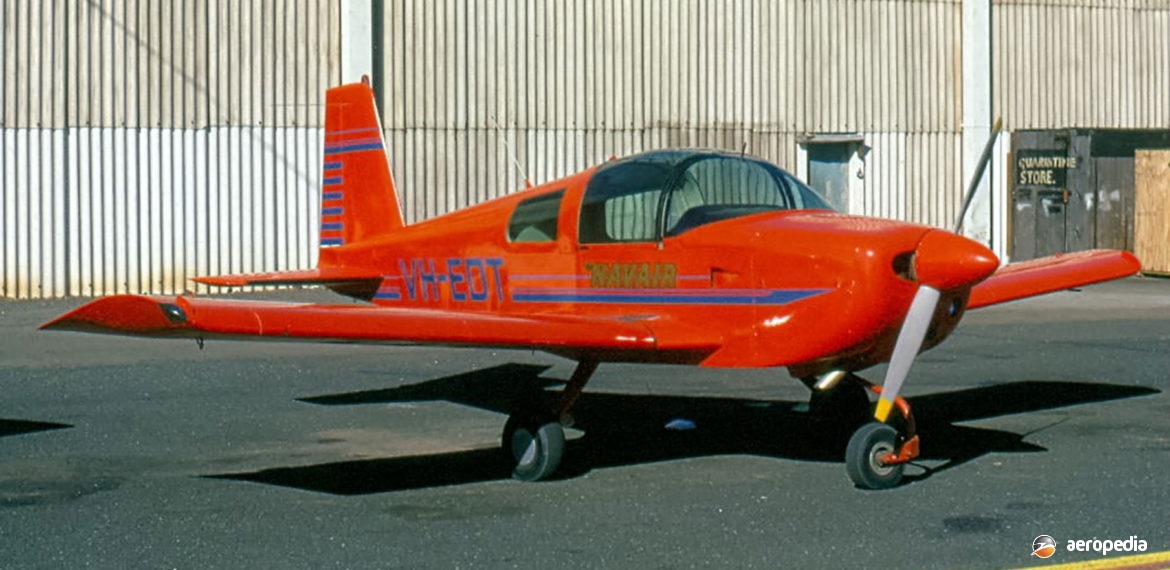Photograph:
Grumman AA-1 VH-EDT (c/n AA-1A-0044) at Bankstown, NSW in July 1972 (David C Eyre)
Country of origin:
United States of America
Description:
Two-seat light touring monoplane
Power Plant:
[AA-1 Yankee] One 81 kw (108 hp) Lycoming O-235-C2C four cylinder horizontally-opposed air-cooled engine
(AA-1B Trainer, AA-1C and T-Cat) One 86 kw (115 hp) Lycoming O-235-L2C four cylinder horizontally-opposed air-cooled engine
Specifications:
- [AA-1C]
- Wingspan: 7.47 m (24 ft 6 in)
- Length: 5.86 m (19 ft)
- strong>Height: 2.32 m (7 ft 7¼ in)
- Wing area: 9.4 m² (100.9 sq ft)
- Max speed at sea level: 218 km/h (136 mph)
- Cruising speed at 75% power at 1,372 m (4,500 ft): 208 km/h (129 mph)
- Initial rate of climb: 228 m/min (750 ft/min)
- Service ceiling: 3,627 m (11,900 ft)
- Range with 45 mins reserve: 543 km (337 miles)
- Empty weight: 455 kg (1,002 lb)
- Loaded weight: 726 kg (1,600 lb)
History:
Th Grumman AA-1 series of aircraft originated from a design by James Bede, the well known American designer of aircraft for amateur constructors. A prototype was flown for the first time on 11 July 1963 as the BD-1, powered by an 81 kw (108 hp) Lycoming O-235-C2C engine, with a wingspan of 7.47 m (24 ft 6 in), the aircraft receiving its type approval in August 1967. Because of considerable interest in the design, production commenced at the facility of American Aviation Corporation in Cleveland, Ohio, which renamed it the AA-1 Yankee, so the Yankee then became the basic aircraft in the series.
In 1971 two new variants with an improved wing and other refinements appeared to meet customer demand. These were the AA-1 Trainer which, as the name denotes, was basically designed to meet the requirements of aero clubs and training organisations. The other, the Tr-2, was a deluxe version intended for private touring. These were later replaced on the production line by the improved AA-1C T-Cat.
The Lynx, a new model, then appeared, with wheel fairings, vinyl fabric interior lining, an improved propeller, and more comprehensive radio equipment. The main external difference between the AA-1C and the AA-1B was an enlarged tailplane, twin shock absorbers in the tubular spring steel nose strut, and a new standard of sound proofing for the cabin to make the aircraft more suitable for cross-country touring.
In the late 1970s production of the series ceased, following the manufacturer’s change of name to Gulfstream American, due to the company’s main interests in large commercial aircraft. Assetts of the company were obtained by Tiger Aircraft and, by August 2006, they were with True Flight Holdings LLC. Some 1,820 examples of the series was built between 1969 and 1978. Due to demand for light aircraft there was a proposal to re-introduce production in 1980.
Ten examples have appeared on the New Zealand register and some 19 examples have appeared on the Australian register.

